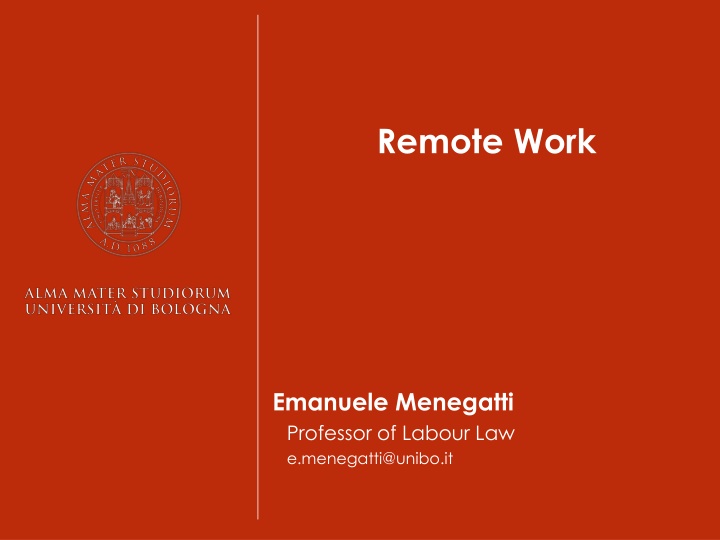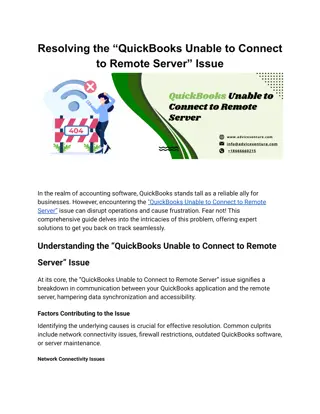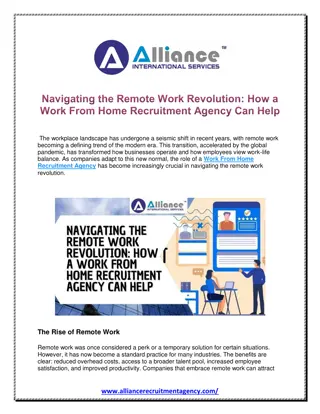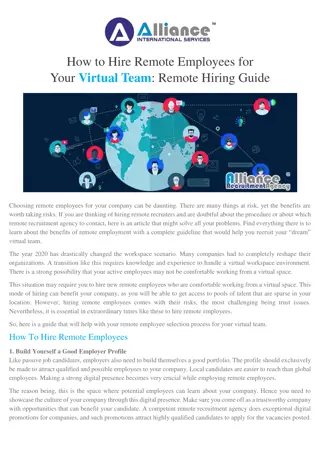
Evolution of Remote Work: Trends, Challenges, and Opportunities
Discover the evolution of remote work, from traditional telework to smart agile work models. Explore the pros and cons for workers, businesses, and society, along with health and safety considerations. Learn how technology and changing work structures are reshaping the way we work.
Download Presentation

Please find below an Image/Link to download the presentation.
The content on the website is provided AS IS for your information and personal use only. It may not be sold, licensed, or shared on other websites without obtaining consent from the author. If you encounter any issues during the download, it is possible that the publisher has removed the file from their server.
You are allowed to download the files provided on this website for personal or commercial use, subject to the condition that they are used lawfully. All files are the property of their respective owners.
The content on the website is provided AS IS for your information and personal use only. It may not be sold, licensed, or shared on other websites without obtaining consent from the author.
E N D
Presentation Transcript
Remote Work Emanuele Menegatti Professor of Labour Law e.menegatti@unibo.it
Once upon a time Telework Peculiar form of homeworking, where information technologies allow the worker to perform outside of the company s premises an activity which could also be carried out in the company Not very popular Rather scattered legislation, addressing: - Health and safety - Prevention of isolation - Working time - Remote checks - Promotion
Rethinking Remote Work Work has been changing Traditional Employment model - Strict subordination and hierarchy - Rigid working time and working place - Low skilled jobs Autonomised Employees - Cooperation and management by objectives - Little relevance of working time and working place - High skilled and specialised workers
From Telework to Smart Agile Work Peculiar execution mode of the employment relationship, organised by stages, cycles and objectives, without strict time and place constraints, involving the use of technological tools for carrying out the work activity outside the business premises, without a fixed location Bringing the office home
Pros and Cons WORKERS - Autonomy and flexibility - Job satisfaction - Work-life balance WORKERS - Isolation - Reduction of career opportunities - Invasion into private sphere - Conflict between working and private life BUSINESSES - Productivity - Cost reduction BUSINESSES - Lower productivity - Less commitment to the company - Increased job planning costs SOCIETY - Reduction of traffic and pollution To be productive and profitable, it requires: - Suitable tasks - Appropriate employee s personality - Adequate technology available - Adaptation of company organisation
Health and Safety Issues: Unavailability of ergonomic work equipment and dedicated working area Overwork Techno-stress and technological addiction, born-out Risk of isolation Employers are responsible for identifying and managing the occupation risks European Telework Agreement Employers, workers representatives and relevant authorities have access to place of teleworking Employees have the right to request inspections Psychosocial risk assessment and management at the company level Involvement of workers representatives
Right to disconnect Blurring boundaries between professional and personal life Proposal for a Directive on the right to disconnect disconnect means not to engage in work-related activities or communications by means of digital tools, directly or indirectly, outside working time - ensure that detailed arrangements are made to enable workers to exercise the right to disconnect, such as arrangements for switching off digital tools; systems for measuring working time; health and safety assessments; criteria for compensation for work outside normal working hours; awareness-raising measures and in-work training to be taken by employers.
Collective rights Improvements in work organisation and change management patterns are necessary Collective negotiations could facilitate this process At the workplace European Telework Agreement - Teleworkers have the same collective rights as workers at the employers premises. No obstacles are put to communicating with workers representatives. The same conditions for participating in and standing for elections to workers representatives Worker representatives are informed and consulted on the introduction of telework - - -






















